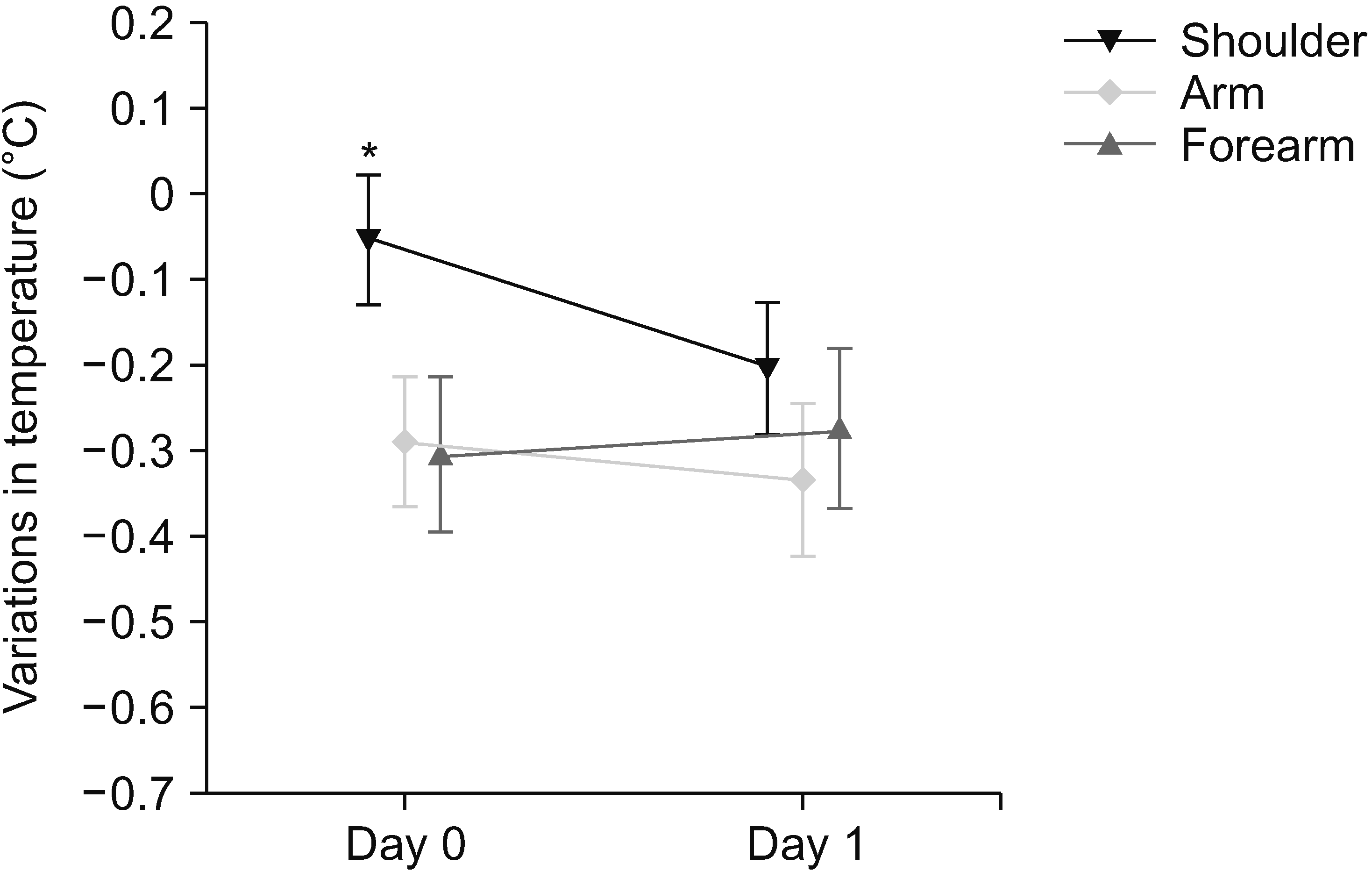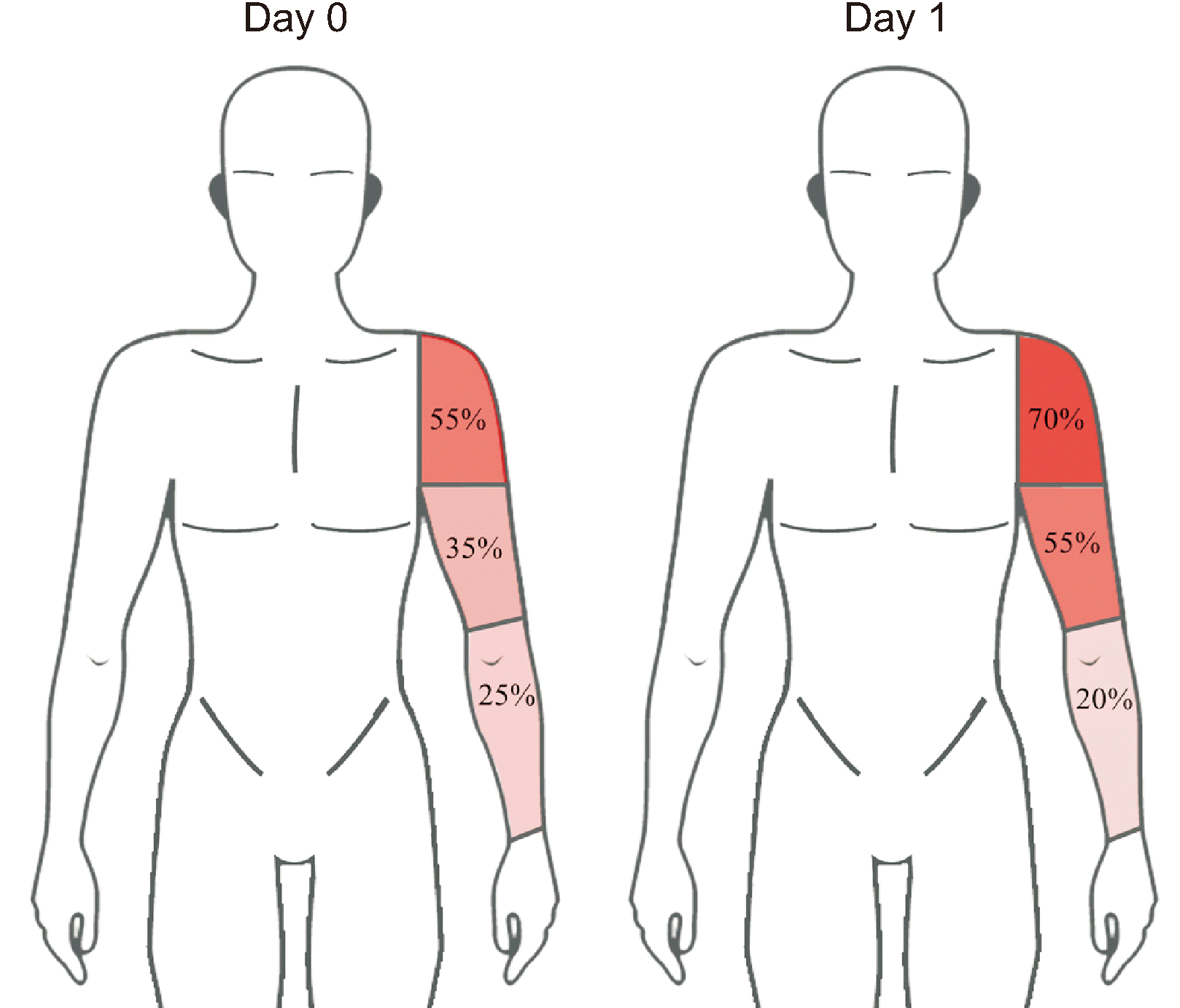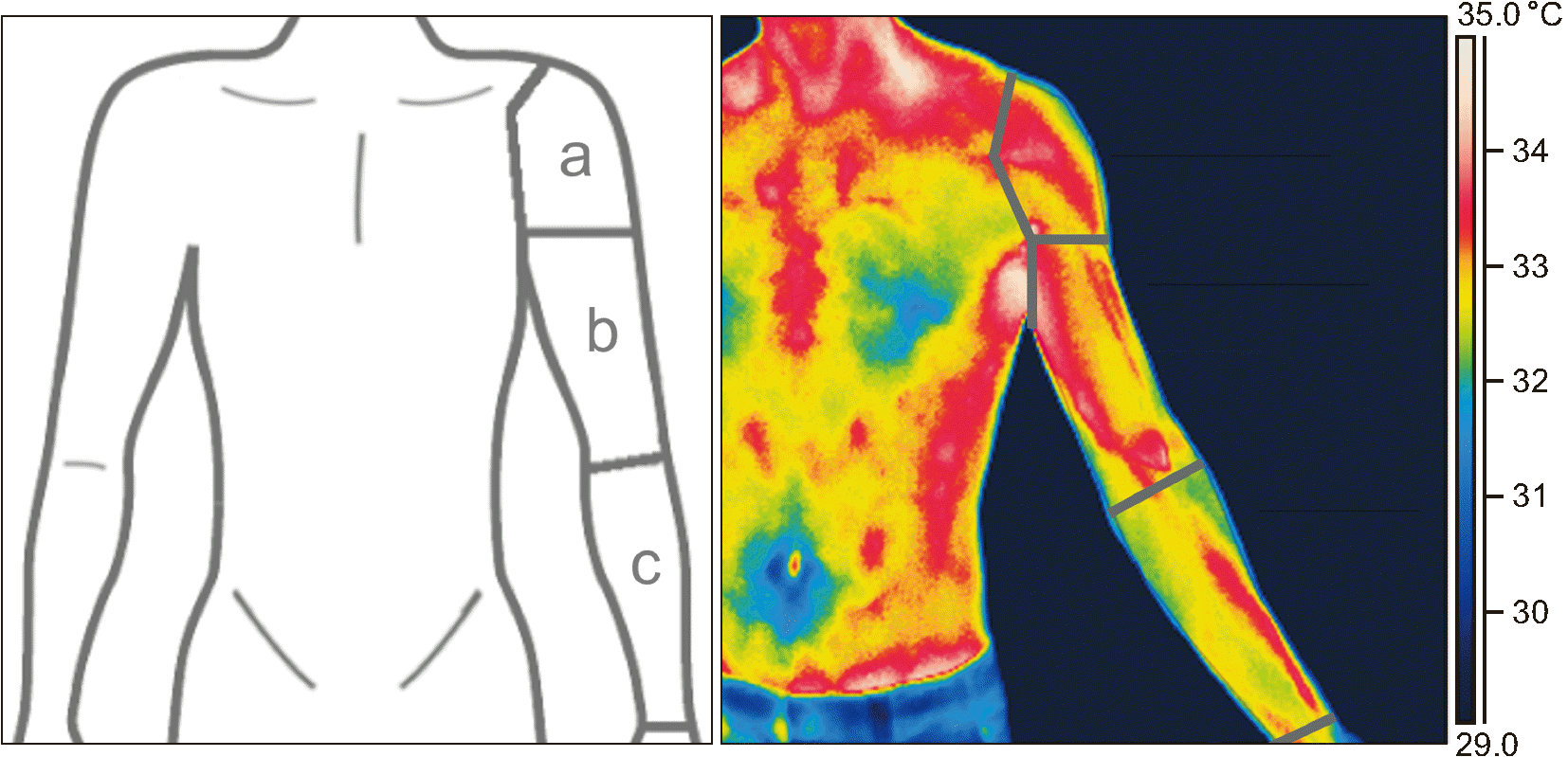1. Steingrímsdóttir ÓA, Landmark T, Macfarlane GJ, Nielsen CS. 2017; Defining chronic pain in epidemiological studies: a systematic review and meta-analysis. Pain. 158:2092–107. DOI:
10.1097/j.pain.0000000000001009. PMID:
28767506.

2. Gerhardt A, Hartmann M, Blumenstiel K, Tesarz J, Eich W. 2014; The prevalence rate and the role of the spatial extent of pain in nonspecific chronic back pain--a population-based study in the south-west of Germany. Pain Med. 15:1200–10. DOI:
10.1111/pme.12286. PMID:
24341931.

3. Vaegter HB, Palsson TS, Graven-Nielsen T. 2017; Facilitated pronociceptive pain mechanisms in radiating back pain compared with localized back pain. J Pain. 18:973–83. DOI:
10.1016/j.jpain.2017.03.002. PMID:
28344100.

4. Graven-Nielsen T. 2006; Fundamentals of muscle pain, referred pain, and deep tissue hyperalgesia. Scand J Rheumatol Suppl. 122:1–43. DOI:
10.1080/03009740600865980. PMID:
16997767.
5. Doménech-García V, Palsson TS, Herrero P, Graven-Nielsen T. 2016; Pressure-induced referred pain is expanded by persistent soreness. Pain. 157:1164–72. DOI:
10.1097/j.pain.0000000000000497. PMID:
26808146.

6. van der Wurff P, Buijs EJ, Groen GJ. 2006; Intensity mapping of pain referral areas in sacroiliac joint pain patients. J Manipulative Physiol Ther. 29:190–5. DOI:
10.1016/j.jmpt.2006.01.007. PMID:
16584942.

7. Dimcevski G, Staahl C, Andersen SD, Thorsgaard N, Funch-Jensen P, Arendt-Nielsen L, et al. 2007; Assessment of experimental pain from skin, muscle, and esophagus in patients with chronic pancreatitis. Pancreas. 35:22–9. DOI:
10.1097/mpa.0b013e31805c1762. PMID:
17575541.

8. Masuda M, Iida T, Exposto FG, Baad-Hansen L, Kawara M, Komiyama O, et al. 2018; Referred pain and sensations evoked by standardized palpation of the masseter muscle in healthy participants. J Oral Facial Pain Headache. 32:159–66. DOI:
10.11607/ofph.2019. PMID:
29561916.

9. Doménech-García V, Skuli Palsson T, Boudreau SA, Herrero P, Graven-Nielsen T. 2018; Pressure-induced referred pain areas are more expansive in individuals with a recovered fracture. Pain. 159:1972–9. DOI:
10.1097/j.pain.0000000000001234. PMID:
29608510.

10. Passatore M, Roatta S. 2006; Influence of sympathetic nervous system on sensorimotor function: whiplash associated disorders (WAD) as a model. Eur J Appl Physiol. 98:423–49. DOI:
10.1007/s00421-006-0312-8. PMID:
17036216.

11. Martinez-Lavin M. 2007; Biology and therapy of fibromyalgia. Stress, the stress response system, and fibromyalgia. Arthritis Res Ther. 9:216. DOI:
10.1186/ar2146. PMID:
17626613. PMCID:
PMC2206360.

12. Zhang Y, Ge HY, Yue SW, Kimura Y, Arendt-Nielsen L. 2009; Attenuated skin blood flow response to nociceptive stimulation of latent myofascial trigger points. Arch Phys Med Rehabil. 90:325–32. DOI:
10.1016/j.apmr.2008.06.037. PMID:
19236988.

13. Larsson SE, Bodegård L, Henriksson KG, Oberg PA. 1990; Chronic trapezius myalgia. Morphology and blood flow studied in 17 patients. Acta Orthop Scand. 61:394–8. DOI:
10.3109/17453679008993548. PMID:
2239160.
14. Morikawa Y, Takamoto K, Nishimaru H, Taguchi T, Urakawa S, Sakai S, et al. 2017; Compression at myofascial trigger point on chronic neck pain provides pain relief through the prefrontal cortex and autonomic nervous system: a pilot study. Front Neurosci. 11:186. DOI:
10.3389/fnins.2017.00186. PMID:
28442987. PMCID:
PMC5386976.

16. Hinojosa-Laborde C, Chapa I, Lange D, Haywood JR. 1999; Gender differences in sympathetic nervous system regulation. Clin Exp Pharmacol Physiol. 26:122–6. DOI:
10.1046/j.1440-1681.1999.02995.x. PMID:
10065332.

17. Hogarth AJ, Mackintosh AF, Mary DA. 2007; Gender-related differences in the sympathetic vasoconstrictor drive of normal subjects. Clin Sci (Lond). 112:353–61. DOI:
10.1042/CS20060288. PMID:
17129210.

18. Lei J, You HJ. 2012; Variation of pain and vasomotor responses evoked by intramuscular infusion of hypertonic saline in human subjects: influence of gender and its potential neural mechanisms. Brain Res Bull. 87:564–70. DOI:
10.1016/j.brainresbull.2011.11.003. PMID:
22100333.

19. Fillingim RB, King CD, Ribeiro-Dasilva MC, Rahim-Williams B, Riley JL 3rd. 2009; Sex, gender, and pain: a review of recent clinical and experimental findings. J Pain. 10:447–85. DOI:
10.1016/j.jpain.2008.12.001. PMID:
19411059. PMCID:
PMC2677686.

20. Hildebrandt C, Raschner C, Ammer K. 2010; An overview of recent application of medical infrared thermography in sports medicine in Austria. Sensors (Basel). 10:4700–15. DOI:
10.3390/s100504700. PMID:
22399901. PMCID:
PMC3292141.

23. Dibai-Filho AV, Guirro RRJ. 2015; Evaluation of myofascial trigger points using infrared thermography: a critical review of the literature. J Manipulative Physiol Ther. 38:86–92. DOI:
10.1016/j.jmpt.2014.10.010. PMID:
25467609.

26. Gibson W, Arendt-Nielsen L, Graven-Nielsen T. 2006; Delayed onset muscle soreness at tendon-bone junction and muscle tissue is associated with facilitated referred pain. Exp Brain Res. 174:351–60. DOI:
10.1007/s00221-006-0466-y. PMID:
16642316.

27. Chesterton LS, Sim J, Wright CC, Foster NE. 2007; Interrater reliability of algometry in measuring pressure pain thresholds in healthy humans, using multiple raters. Clin J Pain. 23:760–6. DOI:
10.1097/AJP.0b013e318154b6ae. PMID:
18075402.

28. Madeleine P, Mathiassen SE, Arendt-Nielsen L. 2008; Changes in the degree of motor variability associated with experimental and chronic neck-shoulder pain during a standardised repetitive arm movement. Exp Brain Res. 185:689–98. DOI:
10.1007/s00221-007-1199-2. PMID:
18030457.

29. Impellizzeri FM, Maffiuletti NA. 2007; Convergent evidence for construct validity of a 7-point likert scale of lower limb muscle soreness. Clin J Sport Med. 17:494–6. DOI:
10.1097/JSM.0b013e31815aed57. PMID:
17993794.

30. Choi E, Lee PB, Nahm FS. 2013; Interexaminer reliability of infrared thermography for the diagnosis of complex regional pain syndrome. Skin Res Technol. 19:189–93. DOI:
10.1111/srt.12032. PMID:
23331254.

31. Kruse RA Jr, Christiansen JA. 1992; Thermographic imaging of myofascial trigger points: a follow-up study. Arch Phys Med Rehabil. 73:819–23. PMID:
1514891.
32. Kimura Y, Ge HY, Zhang Y, Kimura M, Sumikura H, Arendt-Nielsen L. 2009; Evaluation of sympathetic vasoconstrictor response following nociceptive stimulation of latent myofascial trigger points in humans. Acta Physiol (Oxf). 196:411–7. DOI:
10.1111/j.1748-1716.2009.01960.x. PMID:
19210492.

33. Skorupska E, Rychlik M, Pawelec W, Samborski W. 2015; Dry needling related short-term vasodilation in chronic sciatica under infrared thermovision. Evid Based Complement Alternat Med. 2015:214374. DOI:
10.1155/2015/214374. PMID:
25821479. PMCID:
PMC4363707.

34. Skorupska E, Rychlik M, Samborski W. 2015; Intensive vasodilatation in the sciatic pain area after dry needling. BMC Complement Altern Med. 15:72. DOI:
10.1186/s12906-015-0587-6. PMID:
25888420. PMCID:
PMC4426539.

35. Cagnie B, Barbe T, De Ridder E, Van Oosterwijck J, Cools A, Danneels L. 2012; The influence of dry needling of the trapezius muscle on muscle blood flow and oxygenation. J Manipulative Physiol Ther. 35:685–91. DOI:
10.1016/j.jmpt.2012.10.005. PMID:
23206963.

36. Sandberg M, Lundeberg T, Lindberg LG, Gerdle B. 2003; Effects of acupuncture on skin and muscle blood flow in healthy subjects. Eur J Appl Physiol. 90:114–9. DOI:
10.1007/s00421-003-0825-3. PMID:
12827364.

37. Sandberg M, Lindberg LG, Gerdle B. 2004; Peripheral effects of needle stimulation (acupuncture) on skin and muscle blood flow in fibromyalgia. Eur J Pain. 8:163–71. DOI:
10.1016/S1090-3801(03)00090-9. PMID:
14987626.

38. Sandberg M, Larsson B, Lindberg LG, Gerdle B. 2005; Different patterns of blood flow response in the trapezius muscle following needle stimulation (acupuncture) between healthy subjects and patients with fibromyalgia and work-related trapezius myalgia. Eur J Pain. 9:497–510. DOI:
10.1016/j.ejpain.2004.11.002. PMID:
16139178.

39. Lei J, You HJ, Andersen OK, Graven-Nielsen T, Arendt-Nielsen L. 2008; Homotopic and heterotopic variation in skin blood flow and temperature following experimental muscle pain in humans. Brain Res. 1232:85–93. DOI:
10.1016/j.brainres.2008.07.056. PMID:
18680731.

40. Nie H, Arendt-Nielsen L, Madeleine P, Graven-Nielsen T. 2006; Enhanced temporal summation of pressure pain in the trapezius muscle after delayed onset muscle soreness. Exp Brain Res. 170:182–90. DOI:
10.1007/s00221-005-0196-6. PMID:
16328284.

42. Petrini L, Matthiesen ST, Arendt-Nielsen L. 2015; The effect of age and gender on pressure pain thresholds and suprathreshold stimuli. Perception. 44:587–96. DOI:
10.1068/p7847. PMID:
26422905.

43. Riley JL 3rd, Cruz-Almeida Y, Staud R, Fillingim RB. 2020; Age does not affect sex effect of conditioned pain modulation of pressure and thermal pain across 2 conditioning stimuli. Pain Rep. 5:e796. DOI:
10.1097/PR9.0000000000000796. PMID:
32072094. PMCID:
PMC7004505.

44. Ellermeier W, Westphal W. 1995; Gender differences in pain ratings and pupil reactions to painful pressure stimuli. Pain. 61:435–9. DOI:
10.1016/0304-3959(94)00203-Q. PMID:
7478686.

45. Lei J, Jin L, Zhao Y, Sui MY, Huang L, Tan YX, et al. 2011; Sex-related differences in descending norepinephrine and serotonin controls of spinal withdrawal reflex during intramuscular saline induced muscle nociception in rats. Exp Neurol. 228:206–14. DOI:
10.1016/j.expneurol.2011.01.004. PMID:
21238453.

46. Mansfield KE, Sim J, Jordan JL, Jordan KP. 2016; A systematic review and meta-analysis of the prevalence of chronic widespread pain in the general population. Pain. 157:55–64. DOI:
10.1097/j.pain.0000000000000314. PMID:
26270591. PMCID:
PMC4711387.

47. Skorupska E, Rychlik M, Samborski W. 2015; Validation and test-retest reliability of new thermographic technique called Thermovision Technique of Dry Needling for gluteus minimus trigger points in sciatica subjects and TrPs-negative healthy volunteers. Biomed Res Int. 2015:546497. DOI:
10.1155/2015/546497. PMID:
26137486. PMCID:
PMC4475557.

48. Haddad DS, Brioschi ML, Arita ES. 2012; Thermographic and clinical correlation of myofascial trigger points in the masticatory muscles. Dentomaxillofac Radiol. 41:621–9. DOI:
10.1259/dmfr/98504520. PMID:
23166359. PMCID:
PMC3528192.

49. Boudreau SA, Badsberg S, Christensen SW, Egsgaard LL. 2016; Digital pain drawings: assessing touch-screen technology and 3D body schemas. Clin J Pain. 32:139–45. DOI:
10.1097/AJP.0000000000000230. PMID:
25756558.
50. Slater H, Arendt-Nielsen L, Wright A, Graven-Nielsen T. 2005; Sensory and motor effects of experimental muscle pain in patients with lateral epicondylalgia and controls with delayed onset muscle soreness. Pain. 114:118–30. DOI:
10.1016/j.pain.2004.12.003. PMID:
15733637.








 PDF
PDF Citation
Citation Print
Print





 XML Download
XML Download